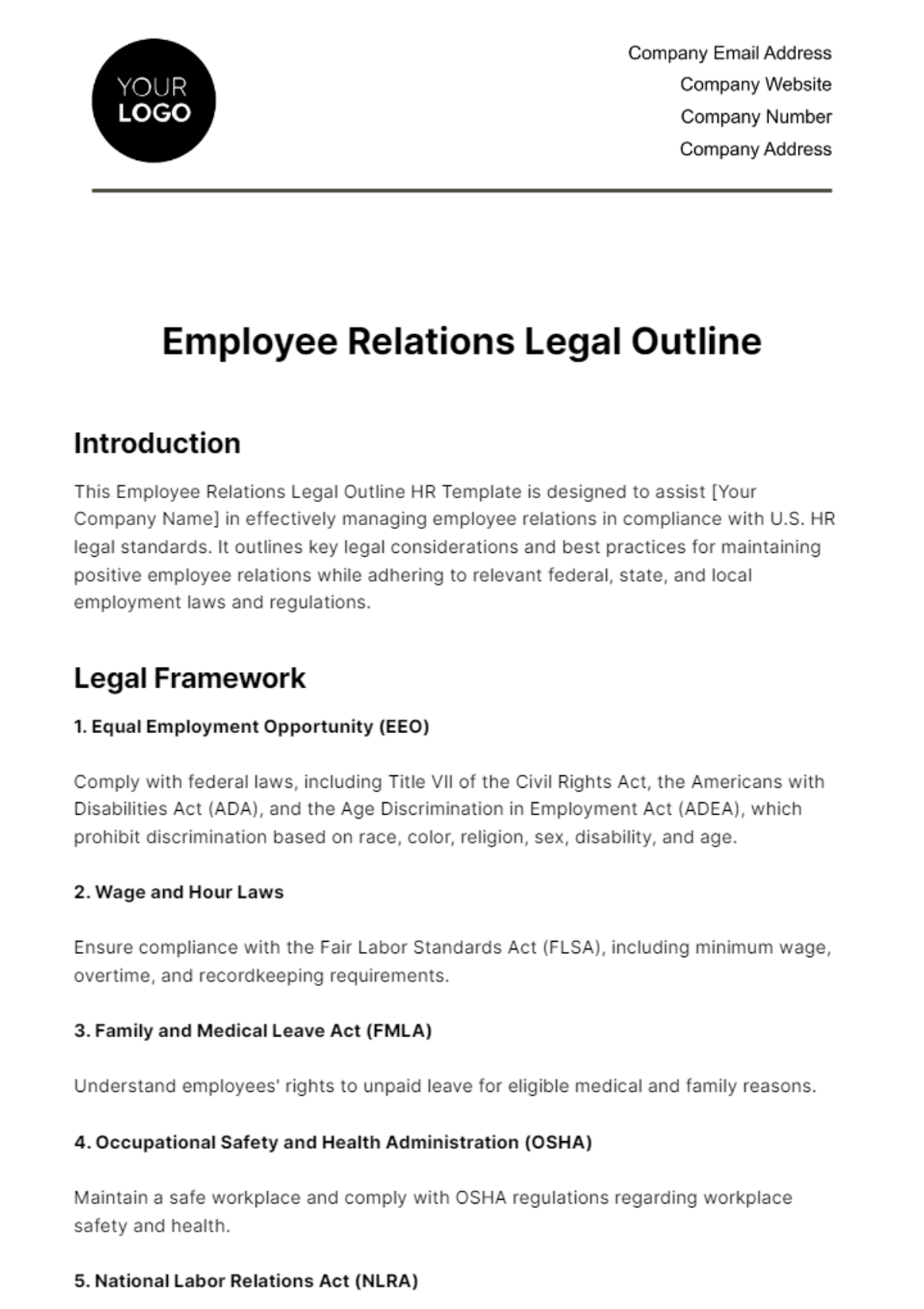Free Employee Relations Legal Outline HR

Introduction
This Employee Relations Legal Outline HR Template is designed to assist [Your Company Name] in effectively managing employee relations in compliance with U.S. HR legal standards. It outlines key legal considerations and best practices for maintaining positive employee relations while adhering to relevant federal, state, and local employment laws and regulations.
Legal Framework
1. Equal Employment Opportunity (EEO)
Comply with federal laws, including Title VII of the Civil Rights Act, the Americans with Disabilities Act (ADA), and the Age Discrimination in Employment Act (ADEA), which prohibit discrimination based on race, color, religion, sex, disability, and age.
2. Wage and Hour Laws
Ensure compliance with the Fair Labor Standards Act (FLSA), including minimum wage, overtime, and recordkeeping requirements.
3. Family and Medical Leave Act (FMLA)
Understand employees' rights to unpaid leave for eligible medical and family reasons.
4. Occupational Safety and Health Administration (OSHA)
Maintain a safe workplace and comply with OSHA regulations regarding workplace safety and health.
5. National Labor Relations Act (NLRA)
Be aware of employees' rights to engage in protected concerted activities and understand the role of labor unions.
Employment Policies and Procedures
1. Recruitment and Hiring
Develop clear policies for recruiting, interviewing, and selecting candidates that align with anti-discrimination laws and promote diversity and inclusion.
2. Onboarding
Provide comprehensive onboarding programs that introduce new employees to company policies, safety protocols, and their rights and responsibilities.
3. Performance Management
Establish performance appraisal processes that are objective, fair, and well-documented.
4. Disciplinary Actions and Termination
Implement progressive discipline procedures and ensure that terminations are legally compliant and well-documented.
Employee Rights and Responsibilities
1. Employee Privacy
Respect employees' privacy rights while ensuring compliance with applicable laws.
2. Accommodation Requests
Address reasonable accommodation requests under the ADA and provide guidelines for the interactive process.
3. Workplace Conduct
Communicate expectations for workplace behavior and provide guidance on preventing harassment and discrimination.
Conflict Resolution
1. Internal Dispute Resolution
Establish internal procedures for addressing conflicts and grievances, including designated contacts and timelines for resolution.
2. Alternative Dispute Resolution (ADR)
Offer mediation or arbitration as options for resolving disputes, ensuring fairness and impartiality.
Discipline and Termination
1. Progressive Discipline
Outline the stages of disciplinary action, from verbal warnings to termination, with clear documentation requirements.
2. Employment Contracts and Collective Bargaining Agreements
Comply with contractual obligations and provide guidance on handling disputes arising from these agreements.
Retaliation Prevention
1. Whistleblower Protections
Protect employees who report violations of laws or company policies from retaliation.
Investigations
1. Internal Investigations
Establish protocols for conducting impartial and confidential internal investigations into allegations of misconduct, discrimination, harassment, or other workplace violations.
2. Documentation
Stress the importance of maintaining accurate records related to investigations, performance evaluations, and disciplinary actions.
Communication
1. Employee Communication
Regularly communicate with employees about their rights, responsibilities, and updates to company policies.
Training and Education
1. Employee Training
Provide training programs that educate employees about legal compliance, ethical conduct, and the prevention of harassment and discrimination.
Compliance Reporting
1. Reporting Procedures
Outline procedures for reporting violations of employment laws or company policies, ensuring confidentiality and protection for whistleblowers.
External Resources
1. Legal Counsel and Government Agencies
Provide information on external resources such as legal counsel, the Equal Employment Opportunity Commission (EEOC), and state labor departments for addressing legal matters.
Updates and Revisions
1. Document Maintenance
Regularly review and update this document to reflect changes in employment laws, regulations, and company policies.
- 100% Customizable, free editor
- Access 1 Million+ Templates, photo’s & graphics
- Download or share as a template
- Click and replace photos, graphics, text, backgrounds
- Resize, crop, AI write & more
- Access advanced editor
Introducing our Employee Relations Legal Outline HR Template–your comprehensive guide to navigating employee relations within HR legal standards. Ensure compliance with confidence, from equal employment opportunity to conflict resolution. Tailor it to your organization's needs and maintain a fair, legally sound workplace. Get started today!
You may also like
- Employee Letter
- Employee ID Card
- Employee Checklist
- Employee Certificate
- Employee Report
- Employee Training Checklist
- Employee Agreement
- Employee Contract
- Employee Training Plan
- Employee Incident Report
- Employee Survey
- Employee of the Month Certificate
- Employee Development Plan
- Employee Action Plan
- Employee Roadmap
- Employee Poster
- Employee Form
- Employee Engagement Survey





























